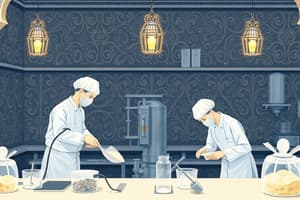Podcast
Questions and Answers
What is required for measuring the sanitizing rinse temperature in a high-temperature dishwashing machine?
What is required for measuring the sanitizing rinse temperature in a high-temperature dishwashing machine?
Maximum registering thermometer
What is the acceptable contact time when sanitizing food-contact surfaces?
What is the acceptable contact time when sanitizing food-contact surfaces?
Soak the item in a chlorine solution for 7 seconds
If food-contact surfaces are in constant use, how often must they be cleaned and sanitized?
If food-contact surfaces are in constant use, how often must they be cleaned and sanitized?
Every 4 hours
What must food handlers do to make sure the sanitizing solution for use on food-contact surfaces has been made correctly?
What must food handlers do to make sure the sanitizing solution for use on food-contact surfaces has been made correctly?
What should be George's first task when getting ready to wash dishes in a three-compartment sink?
What should be George's first task when getting ready to wash dishes in a three-compartment sink?
What feature is most important for a chemical storage area?
What feature is most important for a chemical storage area?
How should flatware and utensils that have been cleaned and sanitized be stored?
How should flatware and utensils that have been cleaned and sanitized be stored?
What is the correct way to clean and sanitize a prep table?
What is the correct way to clean and sanitize a prep table?
What should Pete do after pouring cleaner from its original container into a smaller, working container?
What should Pete do after pouring cleaner from its original container into a smaller, working container?
What information should a master cleaning schedule contain?
What information should a master cleaning schedule contain?
What is the procedure for cleaning and sanitizing stationary equipment?
What is the procedure for cleaning and sanitizing stationary equipment?
What are five factors that affect a sanitizer's effectiveness?
What are five factors that affect a sanitizer's effectiveness?
What is the process of cleaning and sanitizing a three-compartment sink?
What is the process of cleaning and sanitizing a three-compartment sink?
What are 4 instances when a food contact surface must be cleaned and sanitized?
What are 4 instances when a food contact surface must be cleaned and sanitized?
When storing cleaning tools, you should allow them to air dry overnight.
When storing cleaning tools, you should allow them to air dry overnight.
Soaking items for 30 seconds in water at least 171F is an acceptable way to sanitize items.
Soaking items for 30 seconds in water at least 171F is an acceptable way to sanitize items.
Utensils cleaned and sanitized in a three-compartment sink should be dried with a clean towel.
Utensils cleaned and sanitized in a three-compartment sink should be dried with a clean towel.
Cleaning reduces the number of pathogens on a surface to safe levels.
Cleaning reduces the number of pathogens on a surface to safe levels.
Surfaces must be sanitized before they are cleaned.
Surfaces must be sanitized before they are cleaned.
Flashcards are hidden until you start studying
Study Notes
Sanitizing and Cleaning Protocols
- A maximum registering thermometer measures sanitizing rinse temperature in high-temperature dishwashing machines.
- Acceptable contact time for sanitizing food-contact surfaces with chlorine solution is 7 seconds.
- Food-contact surfaces in constant use must be cleaned and sanitized every 4 hours.
Food Handler Responsibilities
- Food handlers should test the sanitizing solution using a sanitizer kit to ensure correct concentration.
- Before washing dishes in a three-compartment sink, the first task is to clean and sanitize sinks and drain boards.
Chemical and Equipment Storage
- Proper lighting is crucial in chemical storage areas to ensure safety.
- Store cleaned and sanitized flatware and utensils with handles facing up to maintain hygiene.
Surface Cleaning Techniques
- The correct procedure to clean and sanitize a prep table includes removing food, washing, rinsing, sanitizing, and then air-drying.
- When pouring cleaner into a smaller container, label the new container with its contents to avoid confusion.
Master Cleaning Schedule
- A master cleaning schedule must detail what needs to be cleaned, when it should be done, by whom, and the methods to be used.
Equipment Maintenance
- When cleaning and sanitizing stationary equipment, unplug the unit, remove parts, wash, rinse, and sanitize surfaces, ensuring contact with the sanitizer, and allow everything to air-dry before reassembling.
Factors Influencing Sanitizer Effectiveness
- Five key factors affecting sanitizer effectiveness include: concentration, temperature, contact time, water hardness, and pH.
Three-Compartment Sink Use
- Proper use involves rinsing, scraping, or soaking items before washing, cleaning in the first sink, rinsing in the second, and sanitizing in the third, followed by air-drying on clean surfaces.
Cleaning and Sanitizing Frequency
- Food contact surfaces must be cleaned and sanitized when: after use, before switching food types, during task interruptions, or every 4 hours if in constant use.
Drying and Safety Practices
- Allow cleaning tools to air dry overnight to prevent bacteria growth.
- Soaking items for 30 seconds in water at or above 171°F is an acceptable sanitizing method.
Myths and Clarifications
- Utensils from a three-compartment sink should not be dried with towels; air-drying is required.
- Cleaning removes dirt; sanitizing is necessary for reducing pathogens to safe levels.
- Surfaces must be washed and rinsed before sanitizing; they should not be sanitized prior to cleaning.
Studying That Suits You
Use AI to generate personalized quizzes and flashcards to suit your learning preferences.




